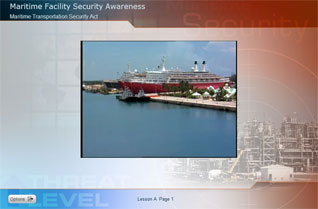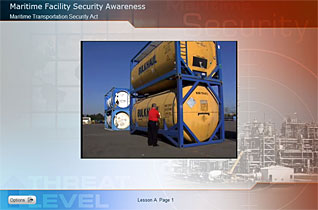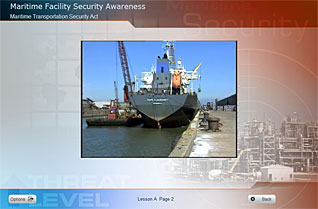Maritime: Security: Maritime Facility Security Awareness

- Product ID
- moximfsa_htm
- Training Time ?
- 45 to 65 minutes
- Language(s)
- English
- Video Format
- Standard Definition
- Required Plugins
- None
- Number of Lessons
- 8
- Quiz Questions
- 18
- Question Feedback
- Wrong Answer Remediation
- Lesson Bookmarking
- Downloadable Resources


Security awareness is an important part in any workplace environment, but especially while working in a maritime facility. This online training program holds the key learning objectives for gaining an effective education when it comes to maritime security.
The viewer is shown why the United States government created the Department of Homeland Security and how it is invaluable to the maritime community. This video, consistent with the requirements in 33 CFR 105.215 for maritime facility personnel and 49 CFR 172 (HM-232) for personnel involved in the shipping of hazardous materials, explains the MARSEC Advisory System, the level of terrorist’s threats, shows the security levels that are based on risk and protective measures. With specific focus on the individual Facility Security Plans and who needs one, the viewer is also shown how to recognize suspicious behavioral patterns and characteristics. Personal safety is another focus in this video, so threat scenarios are described and the detection and recognition of dangerous devices is presented to the viewer for further understanding.
Use this training program as a guide to improve maritime security. Short quizzes follow each video segment to ensure better understanding of the themes at hand.

- Install on any SCORM LMS
- Rich multimedia presentation with interactions and quiz
- Print certificate and wallet card
- You have 30 days to complete the course
Those working in a maritime environment; specifically those involved in maritime security.
-
Maritime Transportation Security Act
- Department of Homeland Security
- The Maritime Transportation Security Act
-
MARSEC
- The Homeland Security Advisory System
-
Facility Security Plan
- MARSEC
-
Suspicious Behavioral Patterns And Characteristics
- SSI
- Suspicious Activities
- Methods Used to By-Pass Security
- Recognition And Detection Of Dangerous Devices
- Emergency Response
-
Understand why the Department of Homeland Security was created.
- State the regulatory requirements of MTSA 33 CFR 105 and DOT 49CFR -172.
- Identify what the Coast Guard protects.
- Choose the Coast Guard as the group responsible for enforcing the MTSA.
-
Understand the Homeland Security Advisory System.
- Name the system developed to indicate the threat level against the general public.
- Differenciate the different color meanings of the Homeland Security Advisory System.
-
Utilize the MARSEC Advisory System.
- Explain the MARSEC Advisory system.
- Differentiate the meanings of the different MARSEC levels.
-
Use the Facility Security Plan as needed.
- Select an example of a facility that must submit a Facility Security Plan for approval.
- Define Security Sensitive Information (SSI).
- Identify times when non-Maritime facilities and shippers may need to submit Security Plans.
-
Recognize suspicious behavioral patterns and characteristics.
- Choose suspicious behavioral patterns.
-
Recognize a suspicious activity.
- Choose suspicious activities that need to be reported.
-
Recognize methods used to by-pass security measures.
- Determine activities that should be closely monitored.
-
Recognize and detect dangerous devices.
- Choose items prohibited on vessles, vehicles, fleets and facilities.
- Name the weapons of choice for terrorists.
- Determine the type of explosive composed of black powder or gunpowder.
- Recognize lights or motion detectors as possible bomb triggers.
- Describe proper precautions to take if an explosive device is discovered.
-
Properly respond to an emergency.
- Recall the organization designating responsibilities for emergency procedures.
- Select the proper action to take in the event of a security incident.
© Mastery Technologies, Inc.



